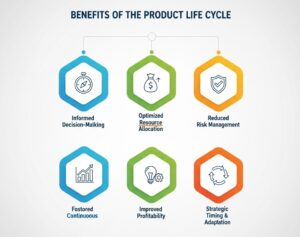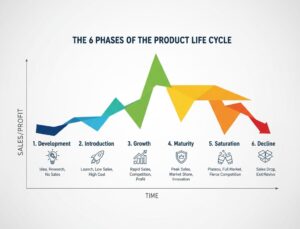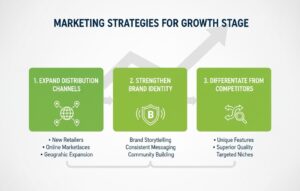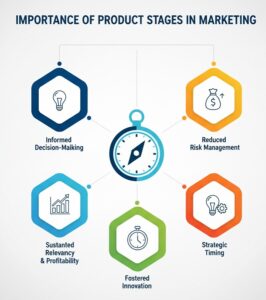All products around us-whether holding an incredible smartphone in hand, ripping an exquisite chocolate from the pouch, or streaming a series or movie on the biggest platform-certainly have their paths. Like human beings, every product goes through birth, growth, maturity, and then decline or transformation.
It is called the Product Life Cycle by marketers. But the twist here is that it is not academic: it is a survival skill. A good company will be one that knows exactly the stage where its product can either invest, innovate, milk profits, or quietly say goodbye.
This is what we will dive into today: the 6 stages of the product life cycle, product stages with examples, and most importantly, how giants like Apple, Coca-Cola, and Netflix do this better than most. You will not only understand why every business swears by this model by the end of it, but also how to use it for real-world marketing.
What is Product Life Cycle in Marketing?
The product life cycle in marketing is a model, which describes all the product stages through which a product passes from its introduction to its decline. For example, each of these product stages requires different approaches in terms of pricing, promotion, and distribution.
Just like a story arc:
- Creation → The product is born.
- Growth → Explosion of sales as people start getting excited about a product in the market.
- Maturity –> Sales flatten off, competition is at its peak.
- Decline –> Ends in fading or morphing.

Typically, you will hear about the 4 stages of the product lifecycle; in modern marketing, however, we frequently enlarge it to 5 stages (which adds Development) or 6 stages (which adds Development and Saturation). That’s what we will present today.
The 6 Product Stages in the Product Life Cycle
Without wasting any more time, let’s roll up our sleeves and get down to the nitty-gritty of each stage along with real-life examples of product life cycles:

Stage 1: Product Development – Where Ideas Are Born
This is the lab phase; it’s the tuning of the background thing to make a thing before the onset of the market actually listening to it.
Companies invest in research, product designing, prototyping, and testing (all these are done by using Figma or other tools). Risky, costly, and super-secretive. There are, at this point, no revenues, just really big dreams and bigger bills.
Example:
- Apple perfected the first iPhone over several years.
- Tesla spent a wealth on R&D before its first Roadster rolled into the world.
Marketing Insight:
At this stage, companies test waters through market research. They may even run pre-launch campaigns to generate a buzz.
Stage 2: Introduction – The Great Launch
This is the moment when products meet the world for the first time. Sales are low, costs are high, and most of it revolves around awareness.
Example:
Netflix when it launched DVD rentals by mail at first was not very popular. People were doubtful.
Coca-Cola Zero Sugar had similarly lackluster early days.
Marketing Strategies for Introduction Stage:
- Heavy levels of promotion to create awareness.
- Penetration (low price to draw in customers) or skimming (high price to cover R&D costs).
- Taking urban adopters, who shall ultimately affect others.
Stage 3: Growth – Rockets Ascending
The product now graduates from introduction into growth. Now the sales shoot up, and profits appear, then competitors start to circle.
Example:
Instagram was like a meteor in its growth phase shortly after which it caught the attention of Facebook, and hence the $1 billion takeover.
The Tesla Model 3 viraled in growth, thus made an electric car known to the world.
Marketing Strategies for Growth Stage:

- Expand distribution channels.
- Strengthening brand identity.
- Differentiation from emerging competitors.
Stage 4: Maturity-the Pinnacle of Power
This is where it peaks at the product end. This is where the sales plateau, rendering saturation in the market. The price of competition is stiff. Innovate or stagnate.
Example:
Coca-Cola has been in the maturity stage for decades, constantly reinventing itself with new flavors and global campaigns.
The iPhone from Apple: would be market leader, but now in the maturity stage for Apple added more incremental innovations.
Marketing Strategies for Maturity Stage:
- Competition in costs.
- Differences in products (e.g., Apple’s Face ID, better cameras).
- Aggressive promotions and loyalty programs.
Stage 5: Saturation – Holding the Fort
Some marketers view this under the maturity stage but, in reality, it is a different pest in and of itself. Sales have essentially ceased to be made and the product is close to reaching its maximum market capacity.
Example:
Facebook’s plateauing in number of users indicates saturation.
McDonald’s in so many countries is tapped out and thus has the never-ending introduction of new seasonal or regionally inspired menu items.
Marketing Strategies for Saturation:
- Product line diversification.
- Access to new markets or geographies.
- Reinforce brand loyalty through engagement.
Stage 6: Decline- The Last Act
All stories must end: It is during this stage where sales decline, people move on, and the product loses relevance in the industry.
Example:
Blockbuster Video collapsed when it failed to adapt itself into a streaming model like Netflix.
The darling of the corporate world, BlackBerry phones, fell when touchscreens and apps became the order of the day.
Marketing Strategies for Decline:
- Either discontinue the product or reinvent it.
- Harvest profits by cutting costs and reducing promotion.
- Explore niche markets where the product may still hold value.
Product Stages Examples
Let’s tie the theory back to some storytelling:
- Coca-Cola: Introduction in 1886, growth in the early 1900s, maturation in the mid-20th century, and still innovative flavors that avoid decline.
- Apple Phone: Introduced in 2007, grew very rapidly until 2014, in maturity/saturation as of now but kept alive by upgrades and loyal fans.
- Netflix: Going from DVD rental (introduction) to streaming, which is growth and maturity. Saturation is now in mature markets but avoiding decline through geographic expansion and original content production.
Why Are Product Stages Important in Marketing?
Understanding product stages in marketing is like having a compass, telling the businesses when to go all out with an advertising blitz, when to cut costs, when to diversify, and when to kill a product. Resource allocation is the wise decision focusing on the long-term relevance of a product for the company.

Product Life Cycle Stages Examples in Marketing Strategy
Each product stages directly corresponds to the marketing decisions that need to be made:
- Introduction: Awareness generation (Apple’s big launches for the iPhone).
- Growth: Gaining market share (Tesla ramping up its operation).
- Maturity: Protect market share (Coke battling Pepsi).
- Saturation: Renew (McDonald’s introducing vegetarian menu in India).
- Decline: Choice to revive or retire (Kodak’s efforts to reinvent itself digitally but too late).
4 Product Stages of Product Life Cycle Vs. 5 Vs. 6
You may inquire, “Wait, isn’t the life cycle just 4 stages?”
Yes. Traditionally it consisted of Introduction, Growth, Maturity, and Decline.
But marketing evolved to start talking about 5 stages of the product life cycle (Development included). Some experts argue for separate consideration, i.e., 6 product stages, with saturation kept apart.
Every number relied upon the framework you’re looking from—but the core meaning remains unchanged.
Product Life Cycle Examples of Brands
- Nike Air Jordans: Resume reinvention over and over again to avoid decline, making a sports shoe a cultural symbol.
- Google Glass: Died in the Introduction stage since the consumers weren’t ready.
- Samsung Galaxy Series: A direct competitor to Apple iPhone, thriving in maturity via continuous innovation.
Common Pitfalls Companies Face During Product Stages
- Throwing money by the ton on dying products.
- Ignoring all signs of saturation.
- Refraing from Innovating during Maturity.
- Aiming for launch without testing.
- Where Are Product Stages Headed in Marketing?
In this era of AI, digital platforms, and swift innovation, product stages are changing faster than ever. Some products sprint from launch to decline within a couple of years (e.g., apps). Others (e.g., Coca-Cola) remain in the maturity stage for decades.
Subset of companies will win because they are the ones who shift their strategies in accordance with the product stage.
Why Product Life Cycle: Product Stages?
The tale of product stages is the tale of business itself. Every product follows a trajectory. The difference is their attitude towards each of these stages.
Understanding the product life cycle is a bit like reading the time from a business clock. Ignore this, and you may repent by being too late on change. Accept this, and you will flow along the tide of innovation and relevance.
Key Terminologies in Product Life Cycle
| Term | Meaning | Example |
|---|---|---|
| Product Life Cycle (PLC) | The stages a product goes through from development to decline. | iPhone evolving from launch to maturity. |
| Introduction Stage | The phase when a product is first launched in the market. | Netflix’s DVD rental launch. |
| Growth Stage | Period of rapid market acceptance and increasing sales. | Instagram’s explosive rise after launch. |
| Maturity Stage | Peak sales but slower growth, heavy competition. | Coca-Cola maintaining leadership for decades. |
| Saturation Stage | When sales stop growing, market capacity is nearly full. | Facebook reaching a plateau in new users. |
| Decline Stage | Demand falls, sales drop, product may be phased out. | Blockbuster collapsing due to streaming. |
| Skimming Pricing | High initial prices to recover R&D costs. | Apple’s early iPhone pricing strategy. |
| Penetration Pricing | Low initial price to quickly gain market share. | Jio’s free/cheap internet launch in India. |
| Product Differentiation | Adding unique features to stand out from competitors. | Apple adding Face ID to iPhones. |
| Harvesting | Reducing investment in a declining product to extract remaining profit. | BlackBerry before its shutdown. |
Skyrocket Your Career with PW Skills – PM with AI Course
Want to master product stages, strategies, roadmaps, and life cycles while learning how AI is transforming the role of product managers? The PW Skills Product Management Course is designed for students, freshers, and professionals who want to upskill in product management. Gain hands-on projects, industry-level insights, and the confidence to ace PM interviews. Future-proof your career today.
The six product stages are Development, Introduction, Growth, Maturity, Saturation, and Decline. The four stages encompass Introduction, Growth, Maturity, and Decline. Developmentand Saturation are included in the six stages. Yes—Coca-Cola (maturity), Apple iPhone (maturity/saturation), Netflix (growth/maturity), and BlackBerry (decline) are classic examples. They help businesses allocate budgets, plan promotions, manage product portfolios, and stay competitive by knowing when to invest, innovate, or retire a product.FAQs
What are the six product stages in marketing?
What distinguishes the four stages from the six stages of the product life cycle?
Are you able to provide examples of brands from the product life cycle?
Why product stages are important in marketing?

